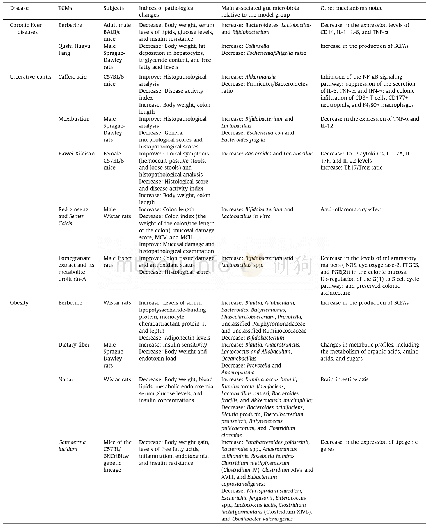《Table 1 Gut microbiota associated changes in non-alcoholic fatty liver disease and Non-alcoholic st
 提示:宽带有限、当前游客访问压缩模式
提示:宽带有限、当前游客访问压缩模式
本系列图表出处文件名:随高清版一同展现
《Prolonged high-fat-diet feeding promotes non-alcoholic fatty liver disease and alters gut microbiota in mice》
1Different from Obese;2Different from Steatosis or non-alcoholic fatty liver disease;3Children and adolescent;4Differences between grouping patients and healthy control.BMI:Body mass index;HC:Healthy control;NAFLD:Non-alcoholic fatty liver disease;NASH:No
Studies have reported that the taxonomic composition of gut microbiota in obese individuals indicates a higher proportion of Firmicutes and a lower amount of Bacteroidetes[14,19].Interestingly,these differences in the ratio of Firmicutes and Bacteroidetes at the phylum level has been not observed in obese NAFLD patients when compared with age matched healthy control subjects[17,18,62-68].In fact,most of the gut microbiota associated changes in NAFLD and NASH occur at the family and the genus level(Table 1).In general,there is not consistent evidence of a specific family or genus involved in NAFLD/NASH.This could be due,in part,to discrepancies in body mass index,stratification of the disease,sex,diet,and the exclusion or inclusion criteria used across studies.Significant findings in our study include an increase in the abundance of Firmicutes and Actinobacteria and a decrease in Bacteriodetes and Tenericutes phylotypes in Old-HFD mice.Consistent with the obesity literature,changes in the Firmicutes phylum were positively correlated with body weight while differences in the Bacteriodetes phylum were negatively associated with body weight.Since changes in Firmicutes,Actinobacteria and Bacteriodetes have been found when comparing obese NAFLD/NASH and lean healthy children and adolescent patients,we believe that the changes observed in these phyla may be related to the body composition and not to the NAFLD pathology.At the genus level,we report an overrepresentation of Adlercreutzia,Coprococcus,Dorea,and Ruminococcus and underrepresentation of Turicibacter and Anaeroplasma abundance in Old-HFD mice.These findings are consistent with some,but not all,of the reported human NAFLD/NASH associated organisms.For example,Raman et al[17]and Del Chierico et al[65]reported elevated representation of Dorea in NAFLD/NASH children,adolescents,and adult subjects,but Da Silva et al[63]observed lower abundance of Dorea in NAFLD patients.In obese post-menopausal women,Dorea genera has been negatively associated with insulin resistance and positively correlated with markers of inflammation[66].Taken together,these studies suggest an association between increased obesity,inflammation,and elevated Dorea genera–which may or may not be related to NAFLD.Consistent with our findings,Boursier et al[19]and Del Chierico et al[65]observed an increase in the abundance of Ruminococcus.Meanwhile,Da Silva et al[63]observed that NAFLD patients had lower fecal abundance of Ruminococcus.Other genera that were altered in the Old-HFD group including Adlercreutzia,Turicibacter,and Anaerosplasma have not been associated with NAFLD or NASH in human patients.Thus,whether changes in abundance of these microbes is due to diet,obesity,or other factors independent of NAFLD warrants further investigation.
| 图表编号 | XD0095326200 严禁用于非法目的 |
|---|---|
| 绘制时间 | 2019.08.27 |
| 作者 | Kandy T Velázquez、Reilly T Enos、Jackie E Bader、Alexander T Sougiannis、Meredith S Carson、Ioulia Chatzistamou、James A Carson、Prakash S Nagarkatti、Mitzi Nagarkatti、E Angela Murphy |
| 绘制单位 | Department of Pathology, Microbiology and Immunology, School of Medicine, University of South Carolina、Department of Pathology, Microbiology and Immunology, School of Medicine, University of South Carolina、Department of Pathology, Microbiology and Immunol |
| 更多格式 | 高清、无水印(增值服务) |





